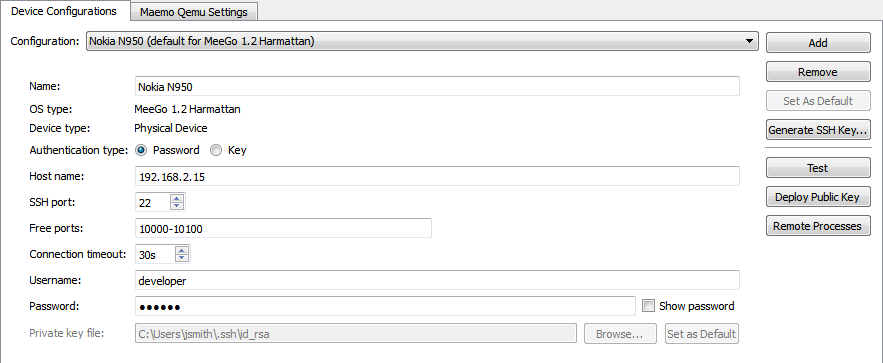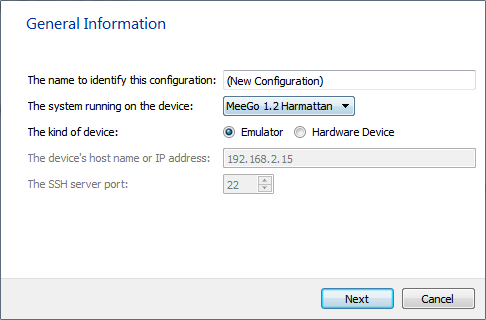Connecting Maemo DevicesMaemo 5 (Fremantle) is a Linux-based software platform developed by Nokia for mobile devices. It allows developers to create applications using the Qt framework. You can install the whole tool chain that you need to create, build, debug, run, and deploy Maemo 5 applications as a part of the custom installation in the Qt SDK online installer. For more information about the Maemo 5 platform, see Software Platform on the Maemo web site. For more information about developing applications for the Maemo 5 platform, select Help > Index and look for Platform Notes, or see Platform Notes - Maemo 5. Hardware and Software Requirements for Maemo TargetTo build and run Qt applications for Maemo 5, you need the following:
Note: The only supported build system for Maemo 5 in Qt Creator is qmake. Setting Up Connectivity in Maemo DevicesYou can connect your device to your development PC using either a USB or WLAN connection. For the device, you need to use a connectivity tool (Mad Developer) to create the device-side end point for USB and WLAN connections. It provides no diagnostics functions but is essential for creating connections between the device and your development PC. To use a WLAN connection, you must activate WLAN on the device and connect it to the same WLAN as the development PC. The network address is displayed in the connectivity tool. To use a USB connection, you need to set up the device as a network device on the development PC. Note: If you plan to connect your development PC to the device only over WLAN, you can ignore the USB-specific parts in the following sections. Installing and Configuring Mad DeveloperInstall Mad Developer on a Nokia N900 device and configure a connection between the development PC and a device. Note: The following instructions describe Mad Developer 2.1. The process and text labels might differ on other Mad Developer versions. To install and configure Mad Developer:
Installing Qt Mobility LibrariesTo develop applications for the Nokia N900 devices that use the Qt Mobility APIs, you must install the Qt Mobility Libraries on the devices. The libraries are not available in the device package manager, and therefore, you must install them from the command line as the root user:
Setting Up USB Connections to Maemo DevicesUse the network configuration tools on your platform to specify the USB connection to the device on the development PC. You do not need to do this if you use a WLAN connection. LinuxThe device uses the IP address 192.168.2.15 with the subnet 255.255.255.0 for its USB connection by default, so you can create the network interface with a different address inside the same subnet too. Note: If you have changed the IP address of the device in the connectivity tool, you need to reflect those changes in your development PC USB network settings. Run the following command in a shell as root user: ifconfig usb0 192.168.2.14 up WindowsWhen you connect the device to your Windows PC, Windows tries to install a driver for the Linux USB Ethernet connection. In the Found New Hardware Wizard, select No, not this time in the first dialog and Install the software automatically in the second dialog. To specify a network connection:
Depending on your version of Microsoft Windows you may have to unplug and re-plug the device to reload the driver with its configuration accordingly. Configuring Connections to Maemo DevicesTo be able to run and debug applications on the Maemo emulator and devices, you must set up connections to the emulator and devices in the Qt Creator build and run settings. If you install Qt SDK, the connection to the emulator is configured automatically and you only need to configure a connection to the device. You use a wizard to create the connections. You can edit the settings later in Tools > Options... > Linux Devices > Device Configurations.
By default, you create the connection as the developer user. This protects real user data on the device from getting corrupted during testing. If you write applications that use Qt Mobility APIs, you might want to test them with real user data. To create a connection as a user, specify the Username and Password in Qt Creator. For more information, see Testing with User Data on Maemo Devices. You can protect the connections between Qt Creator and a device by using either a password or an SSH key. If you use a password, you must generate it in the connectivity tool and enter it in Qt Creator every time you start the connectivity tool. If you do not have an SSH key, you can create it in Qt Creator. Encrypted keys are not supported. For more information, see Generating SSH Keys. You can view processes running on devices and kill them. For more information, see Managing Device Processes. To configure connections between Qt Creator and a device:
Testing with User Data on Maemo DevicesTo run your application as the default user, you must first assign a password for the user account and then create the connection to the device as the user:
Troubleshooting Connections to Maemo DevicesThe addresses used in this example might be reserved by some other application in your network. If you cannot establish a connection, try the following optional configurations:
Note: VPN connections might block the device connection. X
|

























